
Dell XPS 15 vs MacBook Pro 15: Price, specs, performance comparison
 Image: Gordon Mah Ung
Image: Gordon Mah Ung
Dell’s XPS 15 vs. Apple’s MacBook Pro 15 takes its place the same epic list of rivalries as Batman vs. Joker, Red Sox vs. Yankees, and Sheldon vs. Wil Wheaton. Both laptops are intended as workhorses for professionals on the go. And although there are many competitors out there with similar specs, the XPS 15 and MacBook Pro 15 just can’t let the other have the last word.
So in the spirit of competition, we pitted the latest versions of both laptops in a knock-down, drag-out fight.
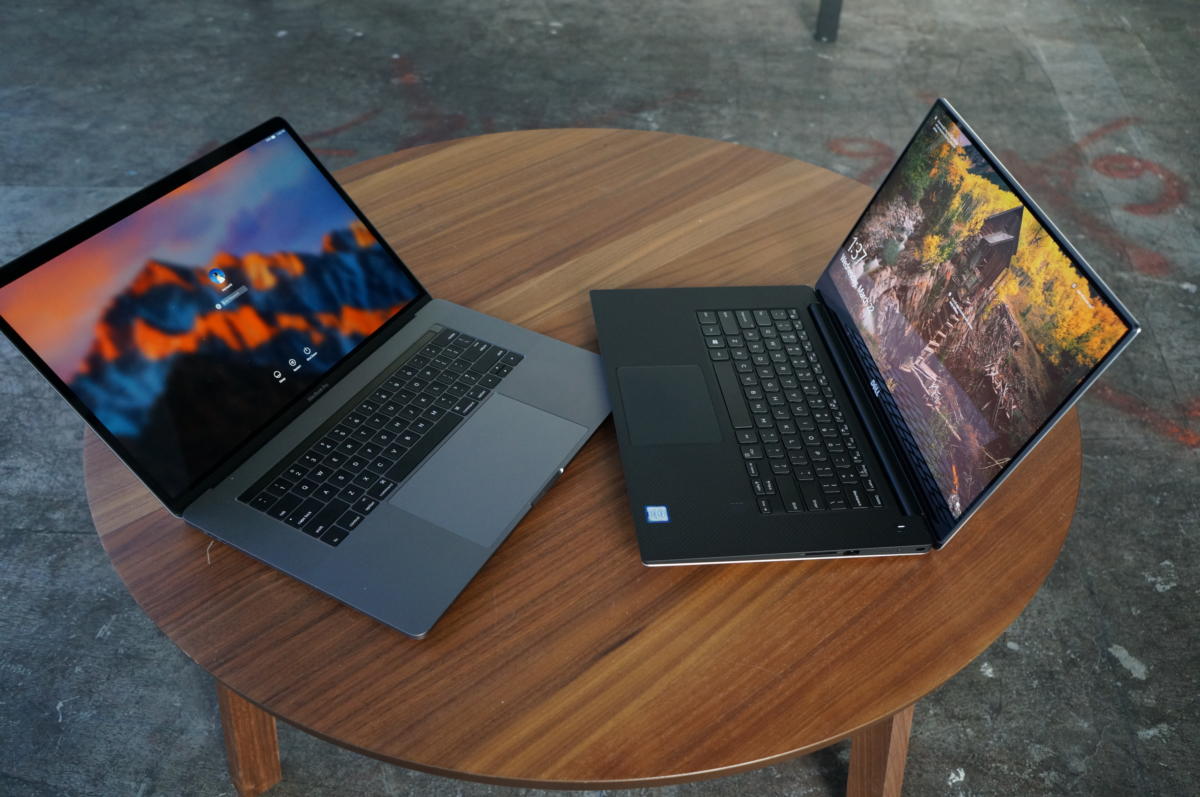 Gordon Mah Ung
Gordon Mah UngThe XPS 15 and MacBook Pro 15 face off yet again.
Ports
The new MacBook Pro 15 has basically four Thunderbolt 3-enabled USB-C ports and a single analog headphone jack (thank god Apple hasn’t killed it this year). You’d think that with $246 billion in hand, Apple would give you a break and include an HDMI dongle or even a USB-Type A to USB-Type C, but no. #ThanksApple.
The Dell XPS 15 is far more generous with traditional ports and gives you two USB 3.0 Type A ports, a full-size HDMI 1.4, analog headset jack, a Kensington lock port, and one USB 3.1 Type C/Thunderbolt 3. In addition to supporting 10Gbps USB-C transfer speeds and the Thunderbolt protocol, this port also supports 4K resolution DisplayPort 1.2.
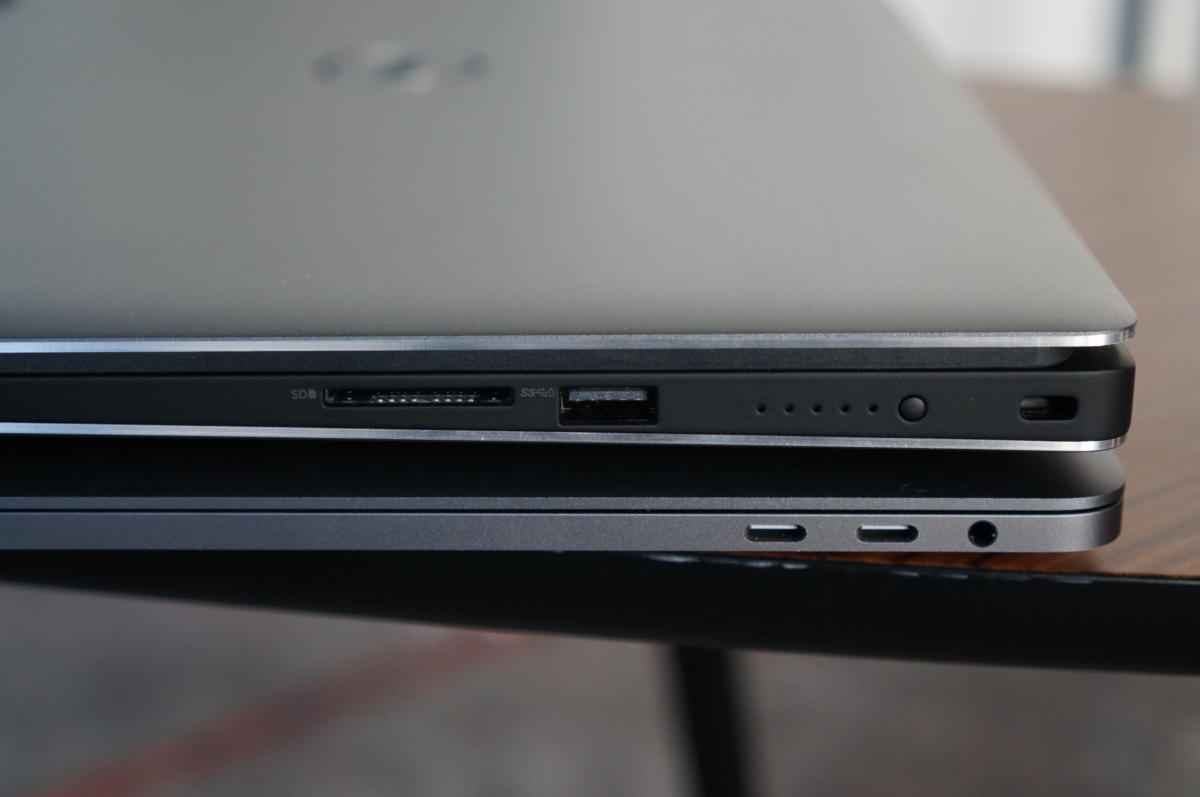 Gordon Mah Ung
Gordon Mah UngDell’s XPS 15 gives you an SD card reader, USB 3.0 Type A and Kensington lock port on the right, as well as a battery meter with five LEDs.
Although Apple Scrooges you on ports, one thing you get for free is performance. The Dell XPS 15’s implementation of Thunderbolt 3 uses two lanes of PCIe Gen 3.0, while all four of Apple’s ports are four-lane implementations, which can hit 40Gbps vs. the 20Gbps of the XPS 15.
The good news for the Dell is that DisplayPort traffic is separate from the Thunderbolt 3 traffic, so you could, in theory, run your monitors and still hit 20Gbps without issue. The bad news is the MacBook Pro 15 does that, too, while giving you up to 40Gbps. Today, few can see use for that speed, but in two years who knows what will be here. So yeah.
As much as I favor Apple’s higher-performance implementation on the MacBook Pro 15, the fact that you can’t use the ports without carrying a small bag of dongles that you have to pay extra for means I’m giving this to the Dell XPS 15, just on general principle.
Winner: XPS 15
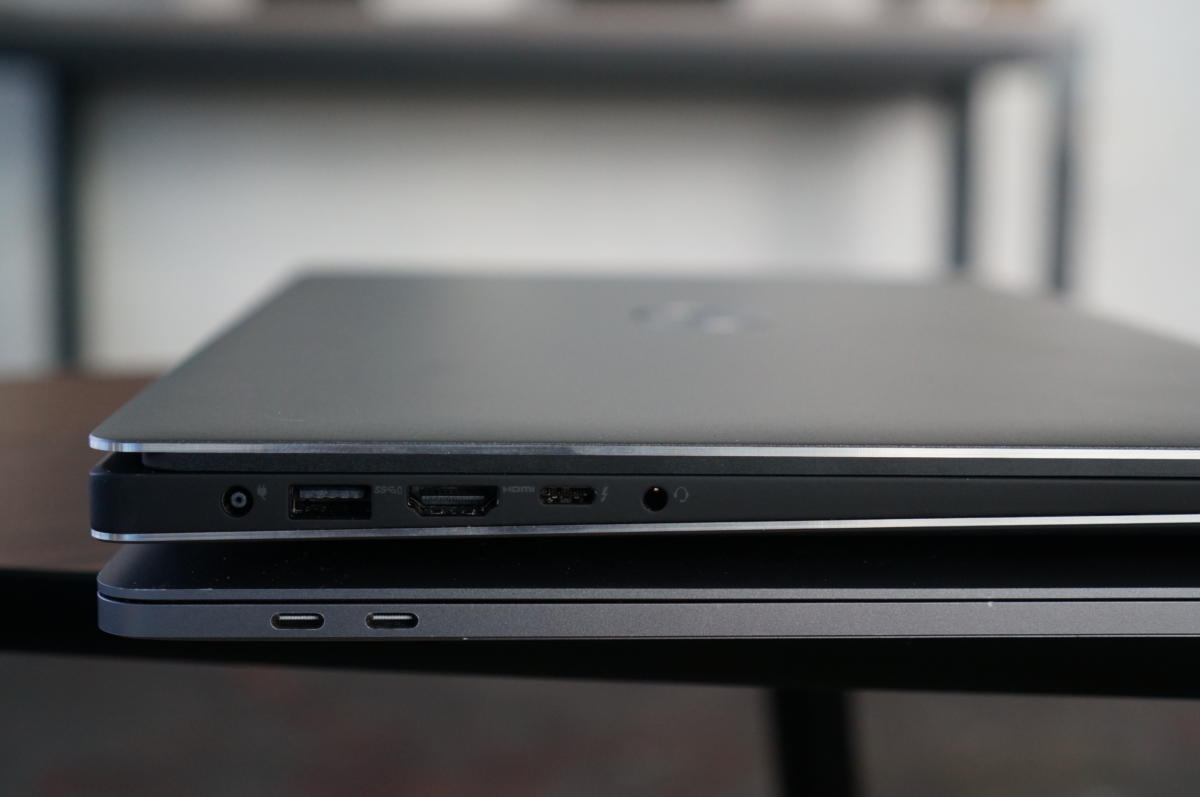 Gordon Mah Ung
Gordon Mah UngWhen it comes to ports, this photo comparing the left sides of the Dell XPS 15 (top) and Apple MacBook Pro 15 (bottom) tells you all you need to know.
Keyboard
With the Butterfly design for its MacBook keyboards, Apple has gone from “making the best laptop keyboards in the world!” to “It’s not really that bad.” Or: “You get used to it, eventually.” Some will even say: “I actually like it. No, really. I’m serious.”
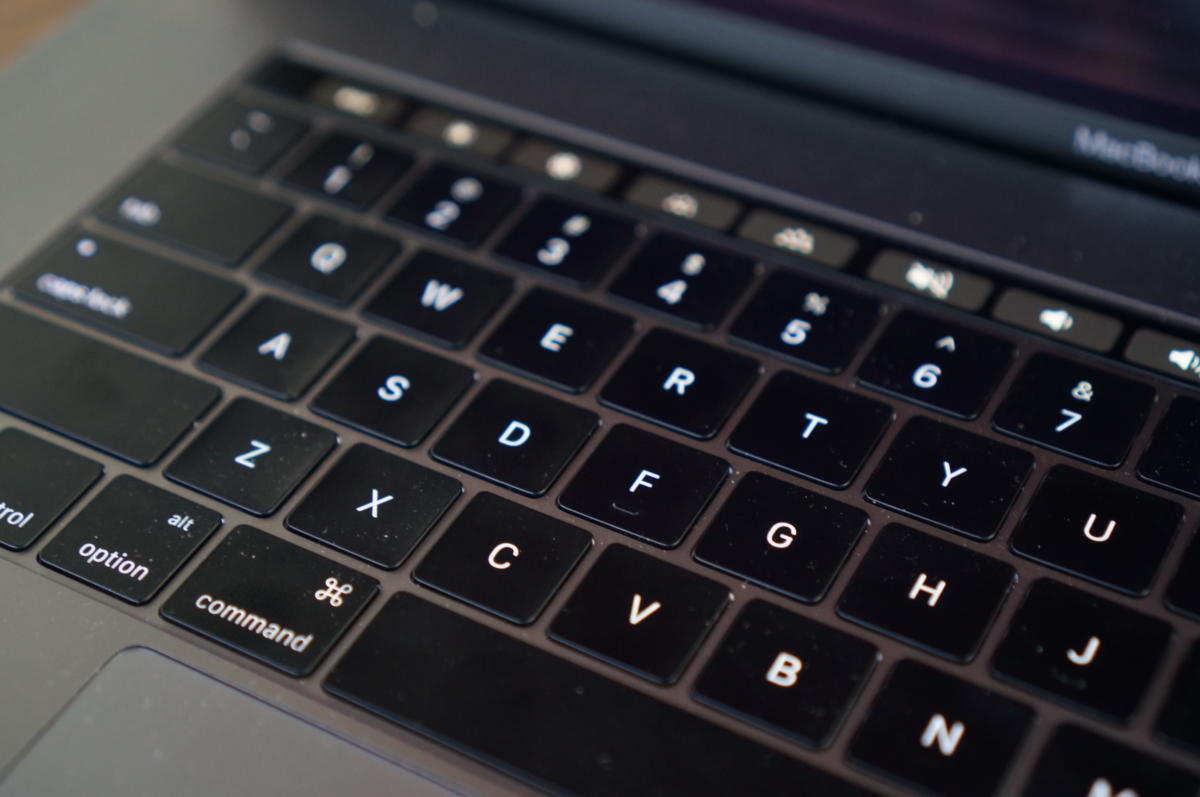 Gordon Mah Ung
Gordon Mah UngThe MacBook Pro 15’s Butterfly keyboard is controversial at best.
Dell’s XPS 15 uses a more traditional keyboard that feels almost like a direct lift from the trendsetting XPS 13. The problem? I think it’s just a little too small. On the tiny XPS 13, it’s a compromise that makes sense. On the larger XPS 15? Let’s just say, it’s not my favorite keyboard, but it’s also not a deal-breaker. In fact, you get used to it.
Winner: XPS 15, but I’m not happy about it.
 Gordon Mah Ung
Gordon Mah UngThe XPS 15’s keyboard is a bit too cramped for my digits, but I’ll take it over the MacBook Pro’s Butterfly keys any day of the week, and three times on Friday.
Trackpad and input
PC trackpads have long been the butt of many well-deserved jokes, but the last few years there’s been little to joke about. MacBook Pro trackpads, meanwhile, have arguably been the benchmark. The one on the MacBook Pro 15 takes it to another level, but I’m entirely sure it makes sense. The trackpad is simply yuge and I don’t know why. I think I’ve seen tablets that are smaller than the trackpad on the MacBook Pro 15. That doesn’t make it bad though, just unusual. Overall it’s nice, with a glass surface and a low friction level. But, man, it’s huge.
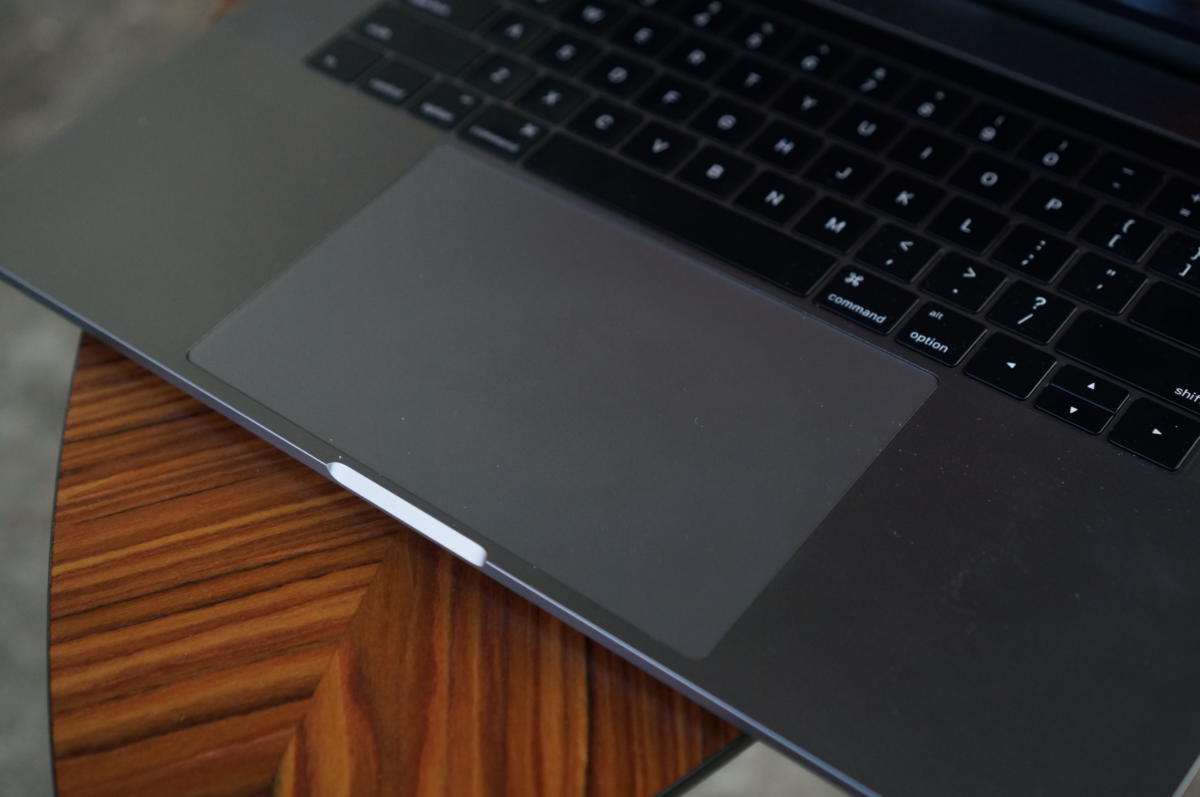 Gordon Mah Ung
Gordon Mah UngThe MacBook Pro 15’s trackpad is so big, it could be a tablet.
The XPS 15’s trackpad (unlike its keyboard) is also highly lauded. The Wall Street Journal, in fact, did nothing in its original review of the XPS 15 but gush over how the XPS 15’s track pad is as good as a MacBook’s. I like it, too. The surface has a little more friction to it, but it’s comfortable to use.
The bigger issue is input beyond the trackpads. The XPS 15 has a full 10-point touchscreen. Sure, you might scoff at the usefulness, but that’s like saying you’d prefer a Blackberry keyboard without touchscreen to, well, today’s smartphones. You get the Touch Bar on the MacBook Pro 15, which is kinda neat, but support for it is still building.
Winner: XPS 15
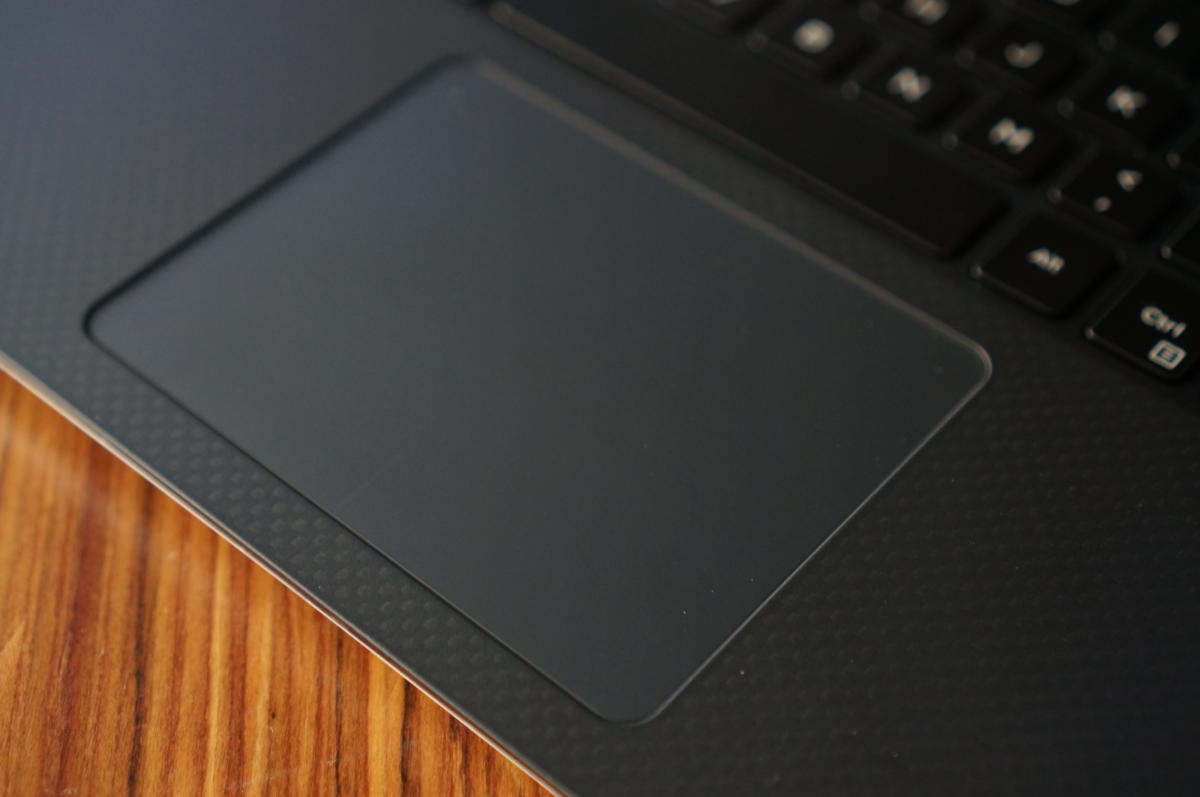 Gordon Mah Ung
Gordon Mah UngThe trackpad on Dell’s XPS 15 is remarkably smooth and responsive.
Size and weight
Physically, the XPS 15 and MacBook Pro 15 are actually pretty close. Sure, the MacBook Pro 15 is pleasantly thin, but in overall footprint, you won’t be able to tell.
More so than how thin it is is how heavy it is. In that category, the MacBook Pro has it in spades. We weighed our MacBook Pro unit at 3 pounds, 15.6 ounces. Yeah, just call it 4 pounds. The XPS 15 is a half-pound heavier at four pounds, 8.7 ounces.
Mind you, these are figures for the main units. Once you add the chargers, it really tilts. The MacBook Pro 15 plus its 87-watt charger (without the extended AC cable) is 4 pounds, 12 ounces. Not bad. The XPS 15 with its brick comes in at 5 pounds, 7.4 ounces. That’s a pretty big weight difference. Once you sling that on your shoulder and walk a mile through an airport, it’ll feel like a 10 pounds’ difference.
It is actually impressive to get to just under four pounds in a quad-core laptop with discrete graphics, but Apple made sacrifices to get there. More performance, in general, means more weight to keep it cooler. For example, the power brick for the Dell is 130 watts, significantly beefier than the 87-watt brick for the MacBook Pro 15.
How much beefier? You’ll have to read on but for now, the MacBook Pro 15 wins.
Winner: MacBook Pro 15
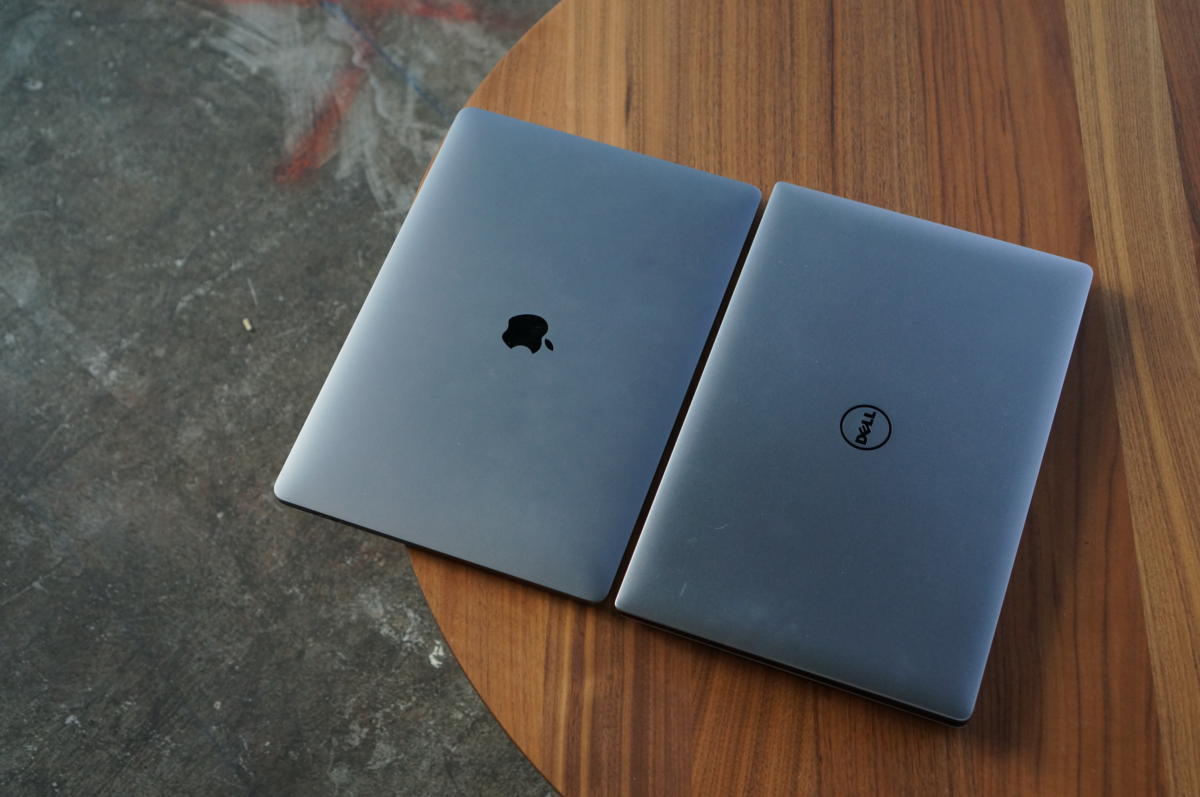 Gordon Mah Ung
Gordon Mah UngThe Dell XPS 15 is slightly bigger in size than the MacBook Pro 15, but it’s really the weight that matters.
Price
We’ve heard about the infamous “Apple tax,” but is it just trash-talking or something real? To find out, we picked a few of the configurations (including the laptops you see here) to compare. We also added a couple of other configurations so you can see just what you get for your dollar with either company.
The MacBook Pro 15 you see here is the base model. It costs $2,399 and comes with a quad-core Core i7-6700HQ, a Radeon Pro 450 GPU, 16GB of RAM, and a 256GB SSD. Compare that to the Dell XPS 15 before you. For $350 less, you get a quad-core Core i7-7700HQ, GeForce GTX 1050, 16GB of RAM, 512GB SSD, and a 4K touchscreen.
Basically, the XPS 15 gives you more performance (which you can see illustrated below) and doubles your storage while saving you $350. Even crazier, you can max out the XPS 15 to 32GB of DDR4 RAM and a 1TB PCIe SSD, and it will only cost $50 more than the base level MacBook Pro 15. For $50 you basically get four times the storage and double the RAM.
Winner: XPS 15
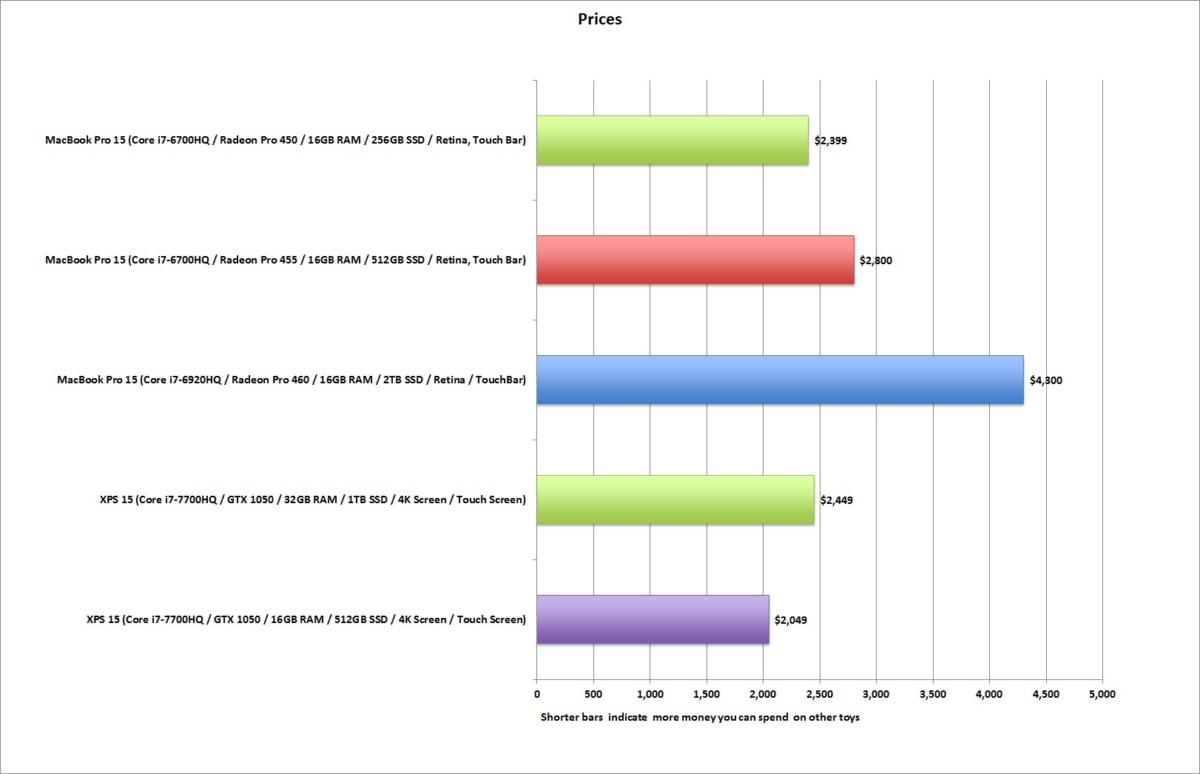 IDG
IDGApple tax? The cheapest MacBook Pro 15 costs as much as the top-end XPS 15.
Upgrades
People have been led to believe that upgrading a laptop is all but dead, because so many components have been soldered down to the motherboard. While you can’t swap the CPU or GPU anymore, it’s not true for all parts. You can, for example, buy the Dell XPS 15 you see here and in two years, open it up and drop in 32GB of RAM and a larger 1TB NVMe PCIe SSD. Not bad.
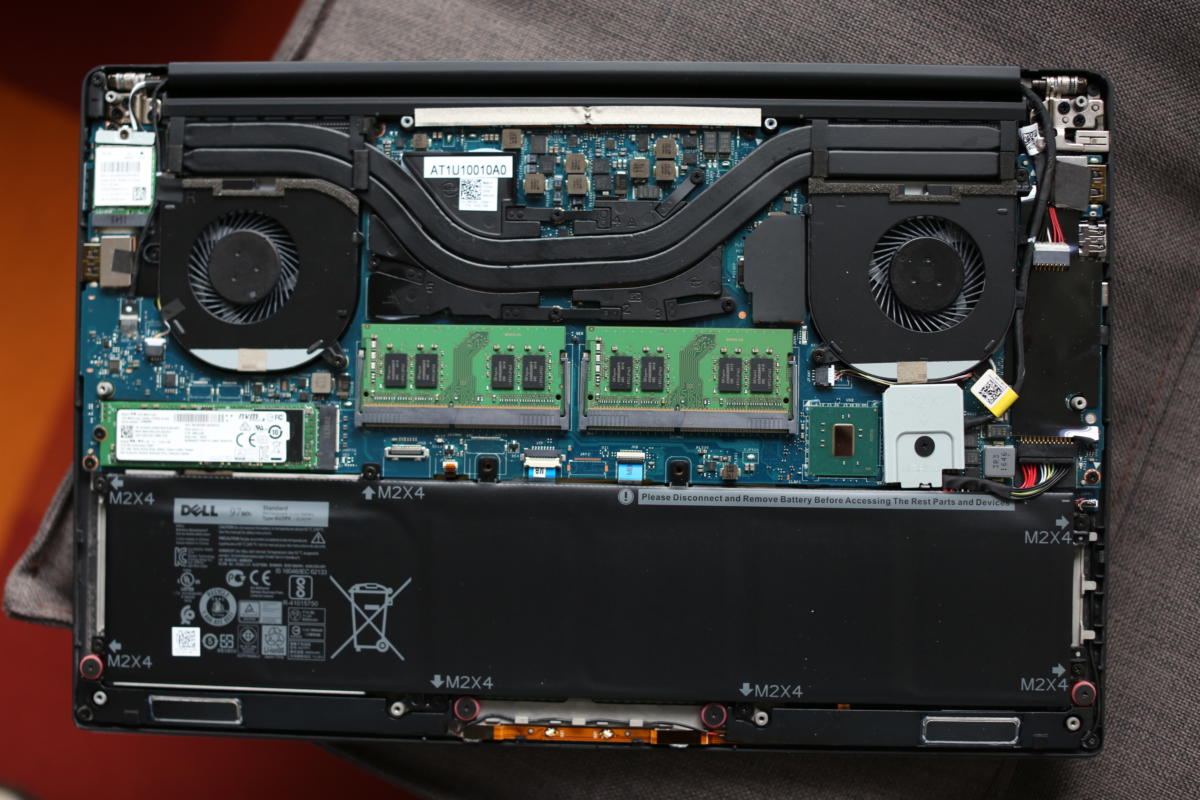 Gordon Mah Ung
Gordon Mah UngYou can’t upgrade the CPU or GPU in the XPS 15, but the RAM, SSD, and Wi-Fi module can be swapped out easily.
Upgrading the MacBook Pro, however, is more problematic. Not only are the CPU and GPU soldered down, but so is the RAM and the even the SSD. The only way to upgrade the MacBook Pro 15 is to open up your browser, point it at a model with more RAM and a larger SSD on Apple.com, and click the Buy button.
I can accept soldered-down RAM because the LPDDR3 precludes use in a SO-DIMM module. But soldering down the SSD? I have to say it’s almost unforgivable.
Winner: Easily the XPS 15
Performance
You don’t shell out big bucks and deal with the weight of a 15-inch laptop just to run a browser on it. No, these laptops are your portable workstation away from the office and are expected to push far heavier workloads than lighter laptops. Thus, performance is key.
To find out which laptop is faster we compared the base $2,399 MacBook Pro 15 with a Core i7-6700HQ, Radeon Pro 450, 16GB of RAM and 250GB SSD against the $2,050 XPS 15 with a Core i7-7700HQ, GeForce GTX 1050, 16GB of RAM, and 512GB SSD.
Crying foul? Think we should pit the XPS 15 against a MacBook Pro 15 with the faster CPU and faster GPU? Here’s why that doesn’t hold water. This MacBook Pro 15 is already $350 more expensive than the XPS 15. If we used the Core i7-6920HQ, Radeon Pro 460 version we’d be comparing a $2,050 PC against a $2,900 Mac, and that’s just silly. And that’s $2,900 for a laptop with an 256GB SSD that can never be upgraded.
Cinebench R15 performance
First up is Maxon’s Cinebench R15 test. This free benchmark measures CPU performance and GPU performance when tasked with rendering 3D scenes, using the same engine used in Maxon’s Cinema4D product. We used the latest version of Cinebench on both Mac and PC.
There’s been much shade thrown at Apple for going with the older 6th-gen Skylake CPU instead of waiting for Intel’s newer 7th-gen Kaby Lake CPU. This first benchmark was to see what these quad-cores could do.
The result: It’s not huge difference unless you count the ability of Kaby Lake to handle HEVC encoding and decoding. You also get higher clocks: The XPS 15’s Core i7-7700HQ CPU has a base clock speed of 2.8GHz and a Turbo Boost of 3.8GHz, while the MacBook Pro 15’s Core i7-6700HQ has a base of 2.6GHz and a Turbo Boost of 3.5GHz (here are the detailed specs of the chips on Intel’s website.)
When confined solely to the x86 cores, we should see maybe a 10-percent or so difference in performance, and yup, that tracks pretty closely with Cinebench R15.
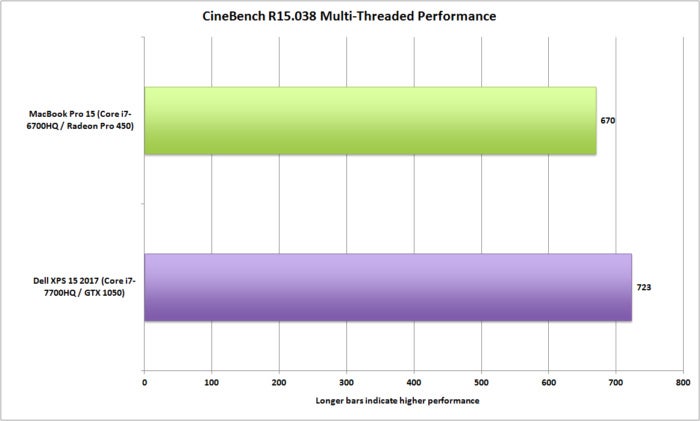 PCWorld
PCWorldCineBench R15 backs up all of our other CPU tests: The XPS 15 is about 10 percent faster than the MacBook Pro 15 (and lower in cost, too!).
CineBench also lets you measure single-threaded performance, which better represents workloads such as using your browser or Office application work. The result is again pretty close to what we expect from Kaby Lake, given its higher clock speeds over Skylake.
Clearly, if you have a Skylake-based laptop—whether PC or Mac—you should be in no rush at all to “upgrade” to Kaby Lake for CPU work. However, if Dell, HP, Lenovo, and just about every other PC vendor can take the time to upgrade to the latest CPU the same way any of us would change our underwear daily, Apple should be able to do the same. It’s like giving up performance because they can’t be bothered to update the specs on the website.
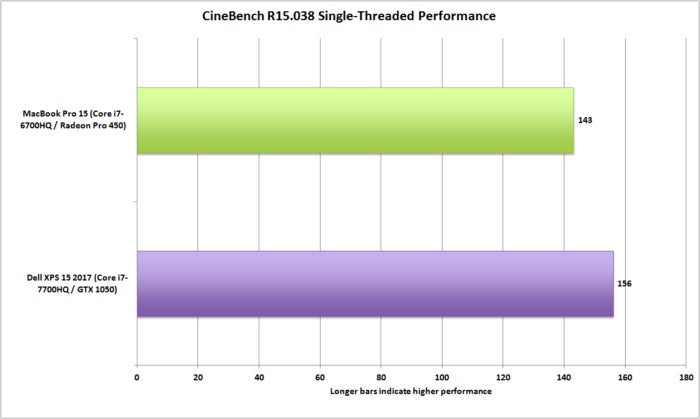 PCWorld
PCWorldSingle-threaded tasks put the 7th generation Kaby Lake about 10 percent ahead of the 6th generation Skylake chip Apple used in its newest MacBook Pro 15.
CineBench also features a built-in graphics test that measures a computer’s OpenGL performance. Although the XPS 15 stomps the MacBook Pro 15 by more than 30 percent, I’d have to say this is a lot closer than I expected it to be. I’d attribute this to the OpenGL driver performance on Windows, which is just about dead, vs. Mac OS where OpenGL is still preferred.
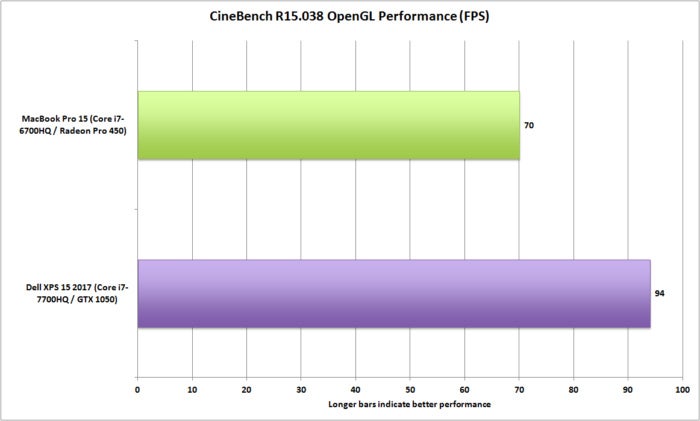 PCWorld
PCWorldHow dismal is the graphics performance disparity between the MacBook Pro 15 and the XPS 15? The fact that the XPS 15 is “only” 35 percent faster in CineBench’s OpenGL test is actually good news for it.
Geekbench Performance
We used Primate Lab’s Geekbench 4.04 to measure the multi-threaded and single-threaded performance of both laptops. Although previous versions of this test invited controversy, the latest version has been better-received as a whole. Using Geekbench within the same x86 architecture seems to be much safer than trying to use it to compare x86 to ARM, too.
Unlike Cinebench, which uses pure CPU rendering as a test, Geekbench uses many different small algorithms modeled after what it feels are valid measurements of performance. Geekbench says the XPS 15 is about 7 percent faster than the MacBook Pro 15, which is what I’d expect.
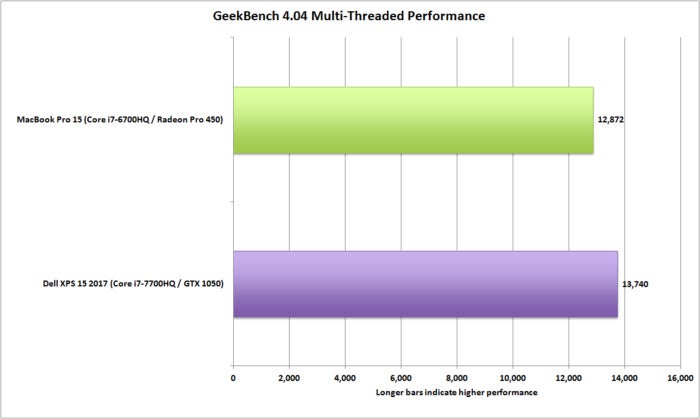 PCWorld
PCWorldAgain, the updated Kaby Lake offers about 10 percent more performance than the Skylake CPU it replaces.
One thing I’ve noticed is Geekbench doesn’t scale quite as well with the number of cores and threads as Cinebench does. When measuring single-core performance, though, it’s a lot closer, and the 10-percent-faster clock speeds of the XPS 15 net you about a 10-percent-higher score than the MacBook Pro 15.
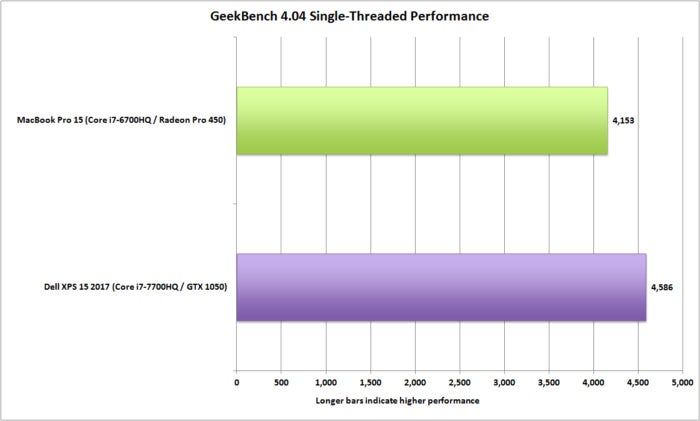 PCWorld
PCWorldIn general, the XPS 15 and its Kaby Lake CPU, is roughly 10 percent faster across the board.
Geekbench also lets you measure the peformance of a computer at OpenCL tasks, which is an open language that lets you do traditionally CPU-bound tests on the GPU. Running on the discrete graphics of the Mac and the PC, we can see a dramatic difference. It’s just not even fair.
 PCWorld
PCWorldThe XPS 15’s GeForce GTX 1050 pretty much eats the MacBook Pro 15’s Radeon Pro 450 for lunch and then uses a Butterflykey for a toothpick.
Turning away from the discrete GPU to the integrated graphics in Geekbench, the results are a lot closer. The Dell still wins, though, with IGP performance about 10 percent faster.
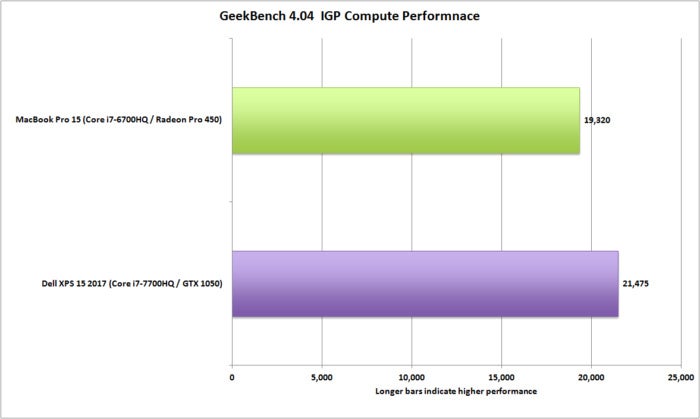 PCWorld
PCWorldIf you were to rely on the onboard graphics chip to handle a compute load, the XPS 15’s Kaby Lake graphics core would be about 10 percent faster than the graphics core integrated with the MacBook Pro’s Skylake chip.
Blender Performance
Blender is an open-source popular rendering app used in many indie movies. It’s maintained on both MacOS and Windows, but performance, unlike in Cinebench, can be uneven across OS versions. For example, rendering is generally faster on Windows 7 than Windows 10, and I’ve found previous builds of Blender ran faster on MacOS.
The current version seems to be pretty even-handed. Using the free BMW benchmark for Blender, the XPS 15 had a nice 10-percent or so performance advantage over the MacBook Pro 15.
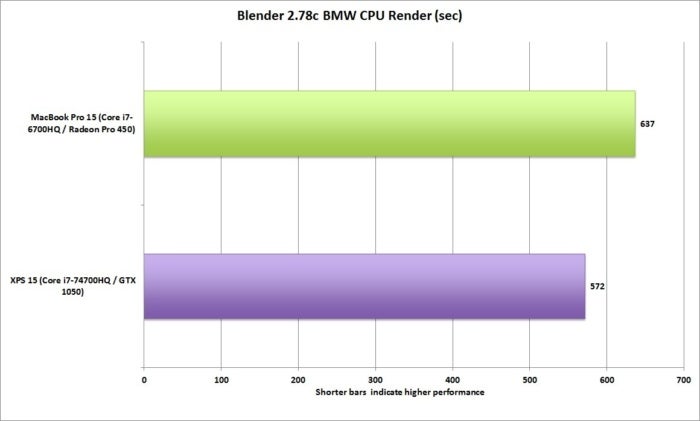 IDG
IDGThe open-source Blender 3D program backs up other CPU-focused tests: The XPS 15 is about 10 percent faster.
Blender also supports using the graphics chip to render 3D. For this test, I tasked both laptops with a GPU render on the GPU version of the Peter Pan BMW test. The XPS 15’s GTX 1050 finish quite swiftly. The MacBook Pro 15 was much, much slower—so much slower, in fact, that it’s pretty apparent the GPU rendering on Blender just doesn’t work right. Again, I’d blame Blender first rather than the Apple, but if you have to do GPU renders: Skip the MacBook Pro 15 for the XPS 15.
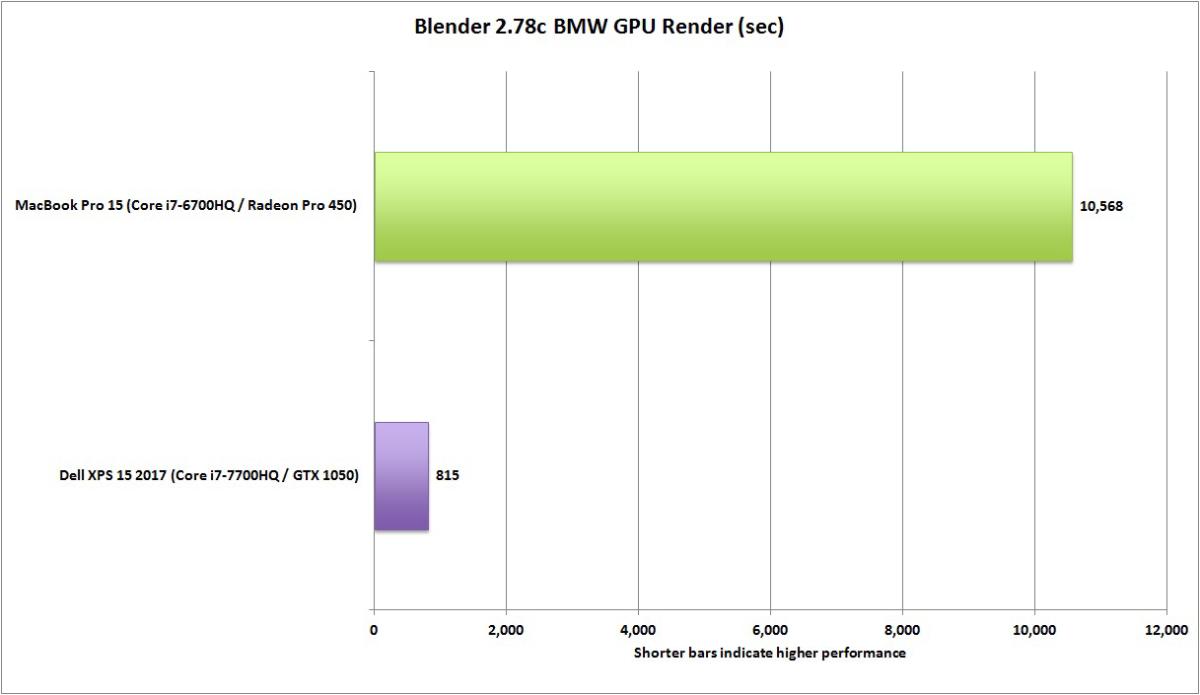 PCWorld
PCWorldOK, well, something isn’t right and hasn’t been for some time in Blender for GPU renders. The XPS 15 finishes in a few minutes, while the MacBook Pro 15 finishes in a few hours. Yes, hours.
Gaming Performance
As PC gaming grows in popularity, so does the importance of graphics performance in laptops. To test these two, I chose Tomb Raider and Middle-earth: Shadows of Mordor. Both were installed from Steam onto the laptops’ respective native operating systems.
The results were downright ugly. First up is Tomb Raider running at 16×10 resolution on High. The Mac pushes about 47 fps which is OK until you realize the XPS 15 is buzzing along at 137 fps. My guess is 19×10 on Ultimate is well within reach for the XPS 15. You’re basically gassed out at 16×10 with the MacBook Pro 15, so getting to a higher resolution would mean compromising on even more visual quality settings.
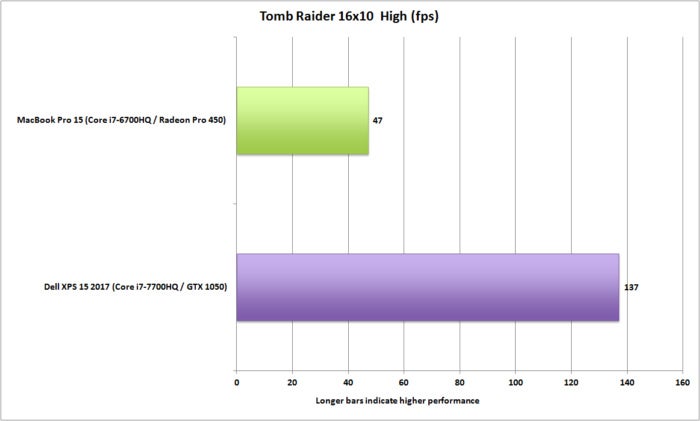 PCWorld
PCWorldIn gaming, it’s nothing but ugly for the MacBook Pro 15 as its low-wattage Radeon Pro 450 struggles to compete with the XPS 15’s GeForce GTX 1050.
The situation is worse for Shadows of Mordor. Mind you, I wasn’t able to run the game at the exact same resolutions, so for High I opted for 1536×864 on the MacBook Pro 15 and 1680×1050 on high on XPS 15. That’s about 1.32 million pixels being rendered on the MacBook Pro 15 vs. 1.76 million pixels on the XPS 15, so the XPS 15 is actually doing about 30 percent more work than the MacBook Pro 15.
One other caveat you should note for both games being tested here: This isn’t a pure test of the GPU or CPU in either system, but also a test of the underlying OS, graphics API, driver, and the game itself.
Rather than see this as a dig on the Radeon Pro chip, you can see this as a dig at Mac-based gaming in general. Basically folks, this is what you get.
Yes, I know you can install Windows 10 (not free) on the MacBook Pro and play games that way, but this would mean Windows 10 is superior to MacOS, and I don’t think anyone ever wants to admit that. The Shadows of Mordor performance is simply atrocious. I can run Shadows of Mordor on the XPS 15 at 19×10 on the Ultra setting and still see a very playable 48 fps, while the MacBook Pro 15 has to step down resolution (and game settings) to be even approachable to playing. Just ugly.
Winner: XPS 15
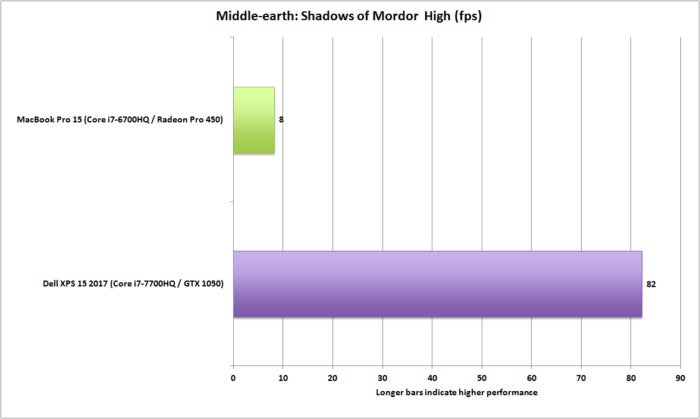 PCWorld
PCWorldIf you looked up ugly in the dictionary it would have a picture of the redesigned MacBook Pro 15 and its Radeon Pro 450 playing Middle-earth: Shadows of Mordor. Because woof.
Battery Life
Laptops are laptops because sometimes you do, indeed, run them on battery. While you’ve heard on the Internets that the MacBook Pro 15 has terrible battery life, the truth is it doesn’t.
For this test, we played a 4K resolution video at about 255 nits in brightness with the Wi-Fi off until the laptops died. The MacBook Pro 15 wins this one hands-down, playing the video for about 9 hours before tapping out. The XPS 15 taps out at about 5.5 hours.
What’s more impressive about those results is their relation to battery capacity. The MacBook Pro 15 packs a fairly small 74-watt-hour battery, while Dell has upped the capacity on the XPS 15 to 97 watt-hours for this year’s refresh.
There are mitigating factors, of course. For the most part, the GPUs are likely not part of the battery life equation, as the video playback of the file is run on the CPU’s graphics chip. Skylake and Kaby Lake probably consume about the same amount of energy doing this simple task.
The Dell XPS 15, does, however have a far denser 3840×2160-pixel screen, versus the MacBook Pro 15’s 2880×1600. In PPI, that’s basically about 226 PPI on the Mac vs 293 PPI on the PC. Lighting up more pixels costs you more power. The XPS 15’s 10-point touchscreen also absorbs some power. Other incidental system power draws, such as the SSD’s, may also come into play here.
Regardless, you can’t explain it away when you have 10 percent left on your battery and you’re only half way through that project. The MacBook Pro 15 is the easy winner here.
Winner: MacBook Pro 15
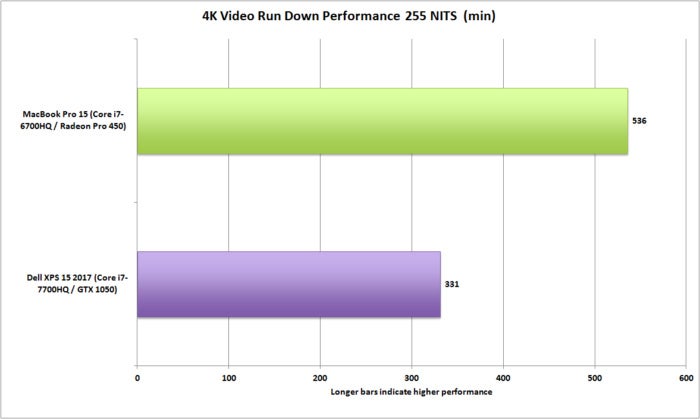 PCWorld
PCWorldThe MacBook Pro 15 may get a bucket of pigs blood dumped over its head in graphics workloads and also easily loses in almost all CPU chores, but it excels in battery life despite the giant battery Dell puts in the XPS 15. Big, big win here for Apple.
Conclusion
The MacBook Pro has a few things going for it: It’s lighter, and it has long battery life under light loads. But in just every other metric used to judge a performance laptop (which quad-core laptops fall into), it’s the Dell XPS 15 that comes up on top. When you factor in the massive cost savings (the top-end XPS 15 cost almost the same as the base MacBook Pro 15), this entire exercise shows this rivalry continues to be entirely one-sided.